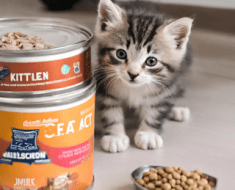We understand the dilemma many pet owners face when introducing new food to their beloved feline companions. It’s not uncommon for cats to exhibit picky eating habits, making the transition to a different diet a potential challenge. However, with patience, persistence, and the right approach, it’s entirely possible to encourage your cat to embrace their new food with enthusiasm. In this comprehensive guide, we’ll explore effective strategies to help your cat adjust to their new diet successfully.
Understanding Your Cat’s Preferences
Assessing Taste Preferences
When introducing a new food to your cat, it’s essential to consider their taste preferences. Cats are known for their discerning palates, often favoring specific flavors and textures. Take note of your cat’s favorite foods and use this information to select a new food that aligns with their preferences. For example, if your cat enjoys fish-based meals, opt for a new food with a similar flavor profile.
Texture Matters
In addition to taste, texture plays a crucial role in your cat’s food preferences. Some cats prefer pate-style foods, while others may prefer chunky or shredded varieties. Experiment with different textures to determine what appeals most to your cat. Offering a variety of textures can also help prevent mealtime boredom and encourage your cat to eat more enthusiastically.
Introducing New Food Gradually
Slow and Steady Approach
When introducing a new food, it’s essential to take a gradual approach. Abrupt changes to your cat’s diet can lead to digestive upset and refusal to eat. Start by mixing a small amount of the new food with your cat’s current diet, gradually increasing the proportion of the new food over time. This gradual transition allows your cat to acclimate to the new taste and texture without causing gastrointestinal issues.
Patience is Key
It’s important to be patient during the transition process. Your cat may initially show reluctance to try the new food, but persistence is key. Avoid resorting to force-feeding or withholding food as these tactics can create negative associations with mealtime. Instead, offer the new food consistently and encourage your cat to explore it at their own pace.
Encouraging Appetite
Enhancing Palatability
To entice your cat to try their new food, consider enhancing its palatability. You can do this by warming the food slightly before serving, as the aroma of warm food is often more appealing to cats. Additionally, adding a small amount of broth or tuna juice to the food can add flavor and encourage your cat to eat.
Scheduled Feeding Times
Establishing a regular feeding schedule can also help stimulate your cat’s appetite. Offer meals at the same times each day and remove any uneaten food after a set period. This helps create a routine and prevents your cat from grazing throughout the day, making them more likely to eat when food is offered.
Monitoring Progress
Observing Eating Habits
As you transition your cat to their new food, closely monitor their eating habits. Keep track of how much they eat and any changes in appetite or behavior. While some initial reluctance is normal, persistent refusal to eat may indicate a problem that requires attention from your veterinarian.
Adjusting as Needed
Be prepared to make adjustments to the transition process based on your cat’s response. If they are struggling to accept the new food, consider slowing down the transition or trying a different flavor or texture. Every cat is unique, so it may take some trial and error to find the perfect food that your cat loves.
Conclusion
Transitioning your cat to a new food requires patience, understanding, and a willingness to experiment. By considering your cat’s taste preferences, introducing the new food gradually, and encouraging their appetite, you can help ensure a successful transition. Remember to monitor your cat’s progress closely and make adjustments as needed to support their health and well-being. With time and persistence, your cat will hopefully embrace their new food with gusto, ensuring a happy and healthy life.
Frequently Asked Questions about Transitioning Your Cat to New Food
1. Q: How long does it typically take for a cat to adjust to a new food?
– Answer: The adjustment period varies from cat to cat. Some may adapt within a few days, while others may take several weeks. Patience and consistency are key during this transition process.
- 2. Q: Should I mix the new food with my cat’s current diet, or switch cold turkey?
– *Answer: It’s generally recommended to mix the new food with your cat’s current diet gradually. This gradual transition helps prevent digestive upset and allows your cat to acclimate to the new food more comfortably. - 3. Q: My cat refuses to eat the new food, what should I do?
– Answer: If your cat is hesitant to try the new food, try enhancing its palatability by warming it slightly or adding a small amount of broth or tuna juice. Additionally, be patient and continue offering the new food consistently, encouraging your cat to explore it at their own pace. - 4. Q: Can I switch back to my cat’s old food if the transition isn’t going well?
– Answer: If your cat is having difficulty adjusting to the new food, it’s important to consult with your veterinarian before making any changes. They can guide the best course of action and may recommend alternative transition strategies or different food options.
5. Q: How can I tell if my cat is having digestive issues during the transition?
– Answer: Keep an eye out for signs of digestive upset, such as vomiting, diarrhea, or changes in stool consistency. If you notice any concerning symptoms, consult with your veterinarian promptly to ensure your cat’s health and well-being are properly addressed.






